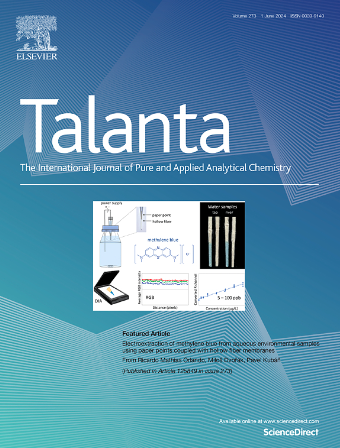RT-RPA-assisted scaffold RNA transcription amplification activation Cas12a trans-cleavage strategy for one-pot miRNA detection
IF 5.6
1区 化学
Q1 CHEMISTRY, ANALYTICAL
引用次数: 0
Abstract
Split crRNA is utilized in the CRISPR system as a highly specific and sensitive tool for nucleic acid identification in molecular diagnostics. Here, we introduce a novel one-pot RT-RPA-assisted Scaffold RNA Transcription Amplification Activation Cas12a Trans-cleavage (ScRNA-TAAT) strategy for miRNA detection. Capable of completing miRNA detection in 50 min with a detection limit of 2.66 aM. The miRNA was amplified into double-stranded DNA amplicons with a T7 promoter using RT-RPA, which is subsequently transcribed into RNA trigger. A split T7 promoter extension sequence with template binds to the RNA trigger, assembly a three-way linker to initiate transcription of the scaffold RNA. The three-way linker with sticky ends joins to its RNA products, assembling a DNA-RNA complex that acts as both a spacer RNA and an activator. Simultaneously, the DNA-RNA hybrid complexes and scaffold RNA could replace the split crRNA and combined with Cas12a, forming an active ribonucleoprotein (RNP) complex with trans-cleavage activity comparable to that of the wild-type Cas12a RNP. Furthermore, we have successfully integrated the ScRNA-TAAT strategy into lateral flow analysis, enabling the visual detection of miRNAs. The assay's exceptional specificity and universality are highlighted by its application to complex biological matrices, including serum and cell lysates. The simplicity, sensitivity, and adaptability of the ScRNA TAAT assay render it a promising candidate for point-of-care testing and high sensitivity in molecular diagnostics.

求助全文
约1分钟内获得全文
求助全文
来源期刊

Talanta
化学-分析化学
CiteScore
12.30
自引率
4.90%
发文量
861
审稿时长
29 days
期刊介绍:
Talanta provides a forum for the publication of original research papers, short communications, and critical reviews in all branches of pure and applied analytical chemistry. Papers are evaluated based on established guidelines, including the fundamental nature of the study, scientific novelty, substantial improvement or advantage over existing technology or methods, and demonstrated analytical applicability. Original research papers on fundamental studies, and on novel sensor and instrumentation developments, are encouraged. Novel or improved applications in areas such as clinical and biological chemistry, environmental analysis, geochemistry, materials science and engineering, and analytical platforms for omics development are welcome.
Analytical performance of methods should be determined, including interference and matrix effects, and methods should be validated by comparison with a standard method, or analysis of a certified reference material. Simple spiking recoveries may not be sufficient. The developed method should especially comprise information on selectivity, sensitivity, detection limits, accuracy, and reliability. However, applying official validation or robustness studies to a routine method or technique does not necessarily constitute novelty. Proper statistical treatment of the data should be provided. Relevant literature should be cited, including related publications by the authors, and authors should discuss how their proposed methodology compares with previously reported methods.
 求助内容:
求助内容: 应助结果提醒方式:
应助结果提醒方式:


